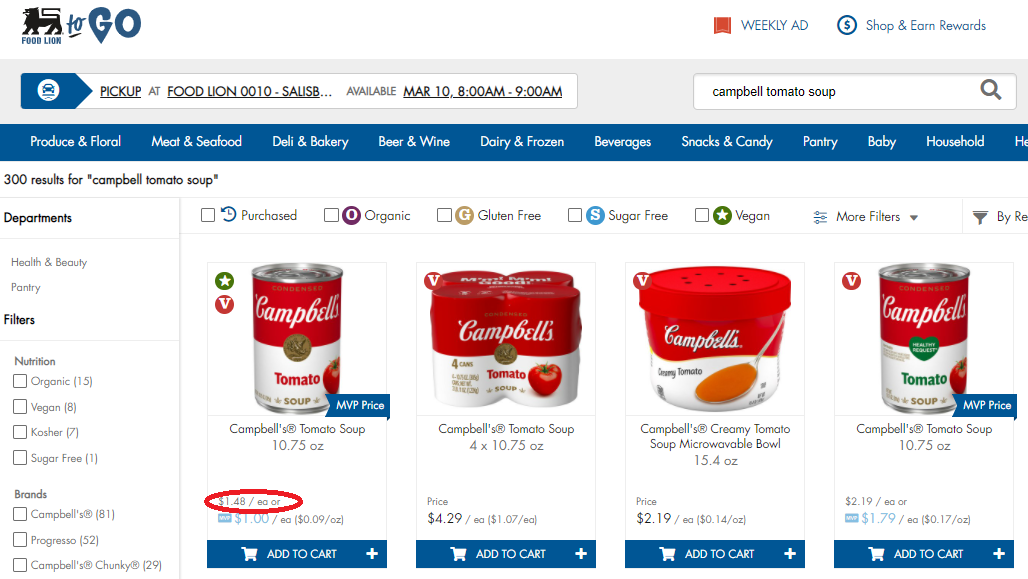Price increases promised by Campbell Soup (NYSE: CPB) CEO Mark Clouse back in December 2021 continued to take hold at grocery stores around the United States since our previous update.
For the latest in our coverage of Campbell's Tomato Soup prices, follow this link!
Here is our summary of prices we surveyed at ten major grocery-selling retailers for March 2022. The most important thing to note is that the discounted sale price per 10.75 ounce can ranges from $0.99 to $1.50 per can, as discounted sale pricing below $0.99 per can has nearly all but disappeared in American grocery stores. Our personal finance tip for tomato soup lovers is that if you find it at $0.99 per can, buy it, because you won't see it at that price for long with President Biden's inflation:
- Walmart: $1.17/each, unchanged
- Amazon: $0.99/each, unchanged
- Kroger: $1.25/each, unchanged
- Walgreens: $1.50/each, unchanged when you buy 2 cans
- Target: $1.19/each, increase of $0.20 (+20.2%)
- CVS: $1.79/each, increase of $0.30 (+20.1%)
- Albertsons: $1.00/each, decrease of $0.25 (-20.0%)
- Food Lion: $1.00/each, unchanged but discounted from $1.48, an increase of $0.19 (+14.7%)
- H-E-B: $1.21/each, increase of $0.20 (+19.8%)
- Meijer: $1.00/each, decrease of $0.29 (-22.5%)
The most notable price increase in this month's update is the 20.2% price increase at Target, the third largest grocery-selling retailer by annual revenue in the U.S. The biggest surprise is the apparent sale of Campbell's Tomato Soup at Albertsons, where shoppers should act quickly to buy soup at the temporary $1.00 per can price level.
But the most interesting price change happened at Food Lion, which didn't change its discounted sale price of $1.00 per can, but did increase its regular shelf price from $1.29 to $1.48 per can. Here's a screenshot of the new higher regular price:
Act quickly, Food Lion shoppers. This stealth price hike is your grocer priming you for what to expect when soup stops being on sale!
As expected, the trailing twelve month average for a can of Campbell's condensed tomato soup rose above the one-dollar per can threshold in March 2022, reaching $1.01 per can and matching its previous record high. American consumers should recognize that all 2021 and 2022's price changes to date for Campbell's Condensed Tomato Soup have had nothing to do with Russia's invasion of Ukraine. They've been in the pipeline for an extended period of time now, where you can thank President Biden's inflation for today's escalating prices.
Speaking of which, Campbell Soup's CEO Mark Clouse indicates that inflation is negatively impacting the company's business, though it is still benefiting from the shopping habits consumers developed to cope with the coronavirus pandemic.
Campbell Soup fell short of market expectations for quarterly revenue on Wednesday, in a sign that demand for its sauces and broths is slowing from the pandemic-led surge.
With the COVID-19 pandemic shutting restaurants across the world, packaged food makers benefited from customers stockpiling at home on frozen meals, snacks, sauces and soups.
However, consumers are now returning to restaurants and former food-ordering habits, which has hit demand for Campbell’s products in recent months.
The company’s organic sales were down 2% in the quarter, as it also wrestled with industry-wide supply chain shortfalls and labor shortages.
Our second quarter was challenging as we lapped a difficult comparison and navigated labor and supply constraints, made even tougher by the Omicron surge,” Campbell Chief Executive Mark Clouse said.
The company indicated it will be able to maintain its full year profit target for 2022, benefitting from more stable levels of worker productivity.
Previously on Political Calculations
Political Calculations' analysis of Campbell's Tomato Soup dates back to 2015, when we first posted historic prices for a No. 1 can of Campbell's condensed tomato soup going back to January 1898! Since then, we've filled in the gaps we originally had in the historic price data and have explored America's second-most popular soup from a lot of different angles. We most recently updated our entire history in January 2022:
That article provides links to our previous coverage, if you want to journey through the tomato soup rabbit hole!
Welcome to the blogosphere's toolchest! Here, unlike other blogs dedicated to analyzing current events, we create easy-to-use, simple tools to do the math related to them so you can get in on the action too! If you would like to learn more about these tools, or if you would like to contribute ideas to develop for this blog, please e-mail us at:
ironman at politicalcalculations
Thanks in advance!
Closing values for previous trading day.
This site is primarily powered by:
CSS Validation
RSS Site Feed
JavaScript
The tools on this site are built using JavaScript. If you would like to learn more, one of the best free resources on the web is available at W3Schools.com.
